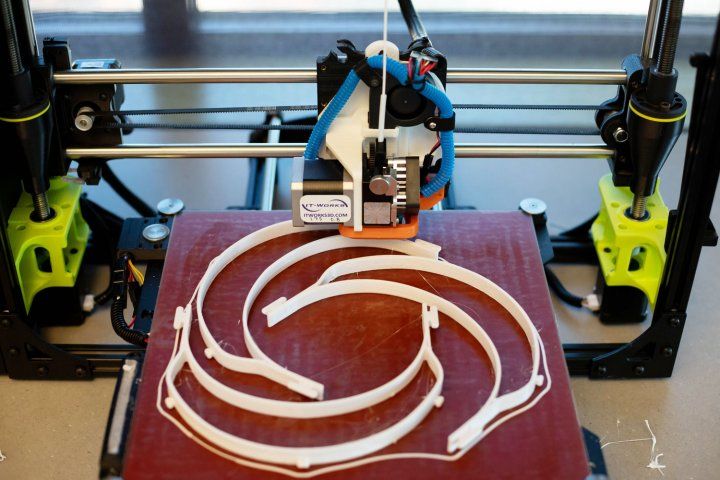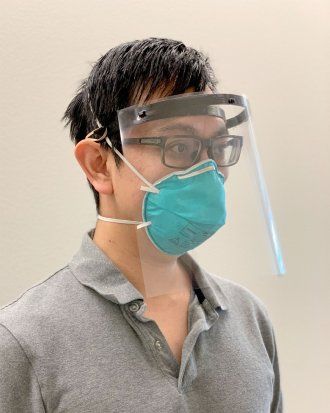Lifesaving Face Shields for Health Care Workers are Newest 3D-Printing Project at UCSF
Using 3D Printers, Team Producing 300 Shields Per Day for UCSF and Beyond, with Increased Production Ahead

A 3D printer making headbands for face shields that will help protect frontline health care workers.
To meet the pressing need for personal protective equipment, or PPE, for frontline health care workers, a multidisciplinary team has mobilized UC San Francisco’s 3D-printing infrastructure to engineer and produce thousands of face shields that can be used by nurses and physicians at UCSF Medical Center and beyond. The team is aiming to produce about 300 of the face shields per day, and they are sharing their printing procedures with the world via the web.
The new shields consist of two main parts: a 3D-printed headband, and a plastic film that attaches to the headband to protect the face. The headband, which can be secured on the wearer’s head using three knotted rubber bands, is made from PET-G, a plastic used in some water bottles. The plastic film, obtained from UCSF’s Documents and Media Group, is a repurposed sheet of the clear plastic used to cover bound reports in schools and businesses.
The report covers are perforated using a 3-hole punch. These holes can be lined up with three small pegs on the headband, suspending the plastic sheet in place.
“This protects a worker’s face from splashes and droplets,” said Ramana Sastry, director of clinical engineering at UCSF Health, who is involved in the project. “This design is key, not only because it’s inexpensive and quick, but also because we’re talking about extended use and reuse.”
The design has been approved by UCSF’s PPE Task Force as well as the departments of Clinical Technologies, Infection Control, and Safety.
The total cost of the materials is less than $1 per shield, and each shield takes about an hour and 20 minutes to manufacture. As an added bonus, the PET-G is recyclable. Comparable face shields in the current environment of scarcity and stalled supply chains cost about $20 each, said Sastry.
After spending over a week fine-tuning the prototype, the team, which brings together experts in biochemistry, engineering, supply chain management, medical workplace safety, and 3D model design, is sharing its printing protocols and continual refinements online, allowing anyone in the world with access to the right materials and equipment to produce the face shields.
The shields are being produced at the UCSF Makers Lab, housed in Kalmanovitz Library, which provides faculty, staff, and students access to tools and space to collaborate.
“Our goal is to direct all resources and staffing to support those on the front lines," said Makers Lab manager Dylan Romero. “We are prepared to do everything possible to help during this crisis.”

Alexis Dang, MD, wearing an assembled face shield.
The team aims to first have shields available for every UCSF clinician working with COVID-19 patients and then begin to distribute to other health care centers. In addition to the “standard” model, the Makers Lab can produce two other versions of the shield: one that offers additional overhead protection, and another that is sized for smaller heads.
“We’ve been able to get started so quickly because we have everything we need in-house at UCSF,” said Alexis Dang, MD, associate professor of orthopedic surgery and co-director of UCSF’s Center for Advanced 3D+ Technologies, who regularly uses 3D printing to make models of bones in preparation for surgeries. Because all elective orthopedic surgeries have been postponed due to the pandemic, Dang and colleagues have focused their energies on the PPE effort, repurposing their 3D printers and providing about 90 percent of the plastic filament being used as the material for the headband pieces.
Dang noted that the face shield project draws on the University’s extensive infrastructure in research, engineering, facilities and materials. “We were able to get clinical technologies and biomedical experts involved very early on, as well as the head of our PPE Task Force,” Dang said.
Dang said he and others recognized early on that there would be a need for additional PPE, which led them to connect with Sastry, who oversees the management of the University’s 40,000 medical devices as well as its supply chain.
Others working on the project include Eric Lam, PhD, assistant professor of biophysics and director of UCSF’s Kavli-PBBR Fabrication and Design Center, Clinical Technologies technical staff Gregory Georgatos and Christopher Wentland, Matt Carlson, MPH, Administrative Director of Safety, Security and Emergency Management, and Mario Camona and Lisa Gee from the Documents and Media Group.
Full production of the face shields began on April 1. Dang noted that they were able to collect a total of 17 3D printers from across campus, half of which had been in clinical use in orthopedics, the other half from the Makers Lab.
To ensure social distancing, engineers operating the printers are partitioned off from each other in separate spaces.
The team is hoping to ramp up production by partnering with manufacturing facilities that have many printers that can be run 24 hours a day. They’ve had some interest from local fabrication facility Humanmade, and out-of-state companies have also expressed interest in making the shields at no cost.
“We’re trying to respond to the anticipated scarcity,” said Sastry, pointing out that in hard-hit cities like New York, face shields and the materials to produce them are hard to find. “We’re getting ahead of that game, not only making our own supply, but getting out there to provide these to anyone else who needs them as well.”